Adventure
Timeless Footsteps
-John Eickert
There are extraordinary trekking opportunities. There are many places to trek throughout the world, but some are special. For me, special elements create a special trek. Wildlife, solitude, scenery, culture, and difficulty
are some of those elements. The trek over Wari La, an ancient route linking the Indus valley in Ladakh with the Shyok/Nubra valleys, adds another element to the list, a chance to follow timeless footsteps. Since man found he was not alone he has traded with
his neighbors. The grains grown in Ladakh have been transported over high passes to Panamik. Lasirmou La, Khardung La, Digar La, and Wari La are some of these passes. The traders making the return trip brought dates and apricots up to Ladakh. Now, Khardung
has a road and the others are seldom used, perfect for trekking.
My plan was to ride to Panamik and walk back to Leh via Wari La and Tak Tok. I hoped Khardung would provide acclimatization and this agenda would conceal my intention. At that time, permits were not being issued for trekking
over Wari La. In Panamik, I walked the sand dunes and rode a camel. I met a man who was willing to use his pack pony for our trek. My partner and guide then intended to sell his pony in Leh and return via Khardung. We planned for a seven-day outing.
On the first day, we walked to Khalsar. The next day was some uphill to Agham. From Agham it took three days to cross Wari. The day over the pass was long and the trail was very steep. The north
side of the pass held much snow though it was high summer. On the south side, we stopped at a herder’s shelter and were glad for the day to end. I had hoped I might see some of the peaks of the Karakoram, but they were too far. As we sat that night watching
the sky and eating a dinner of rice and apricots I considered how many footsteps had crossed that pass in the previous millennia. They crossed not seeking adventure, but trade. The next day we walked to Tak Tok. The day after I caught a ride into Leh and said
farewell to my partner and his pony. As we waved, good-bye, I considered the previous six days and the time spent trekking with someone who spoke a mixture of Tibetan and Ladakhi, but no English. Somehow, we got on just fine.
To walk from sand dunes to glaciers along an ancient route is an opportunity to follow many footsteps and walk in time. We saw marmots, blue sheep, a lone Siberian Ibex, and a pair of golden eagles. We saw no one
when crossing Wari La and there were no human footprints in the summit snow. It was hot in Panamik and freezing in Tak Tok. I spent one last day in Leh and then flew to Delhi. When will you go? Cheers. 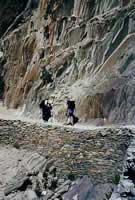
|
Common Birds of India
Red-whiskered
bulbul- Pyconotus jocosus.
-Ragoo Rao
Anyone with a beautiful voice is compared to a Bulbul.
Such is the beautiful voice this lovely bird with a brown body white underbody with a blackish necklace on the breast.
As the name suggests it has a white and black patch of whiskers just below the eye and the head is almost black with a feathery crest on top.
The tail has a white band at the tip and there is a red patch at the vent.
Distribution is throughout the country except for very arid regions.
They are always found in pairs hopping from tree to tree with their polyphonic singing chirps.
It is its voice which draws attention and then you locate the bird.
There are quite a few variations in bulbuls all based on coloration.
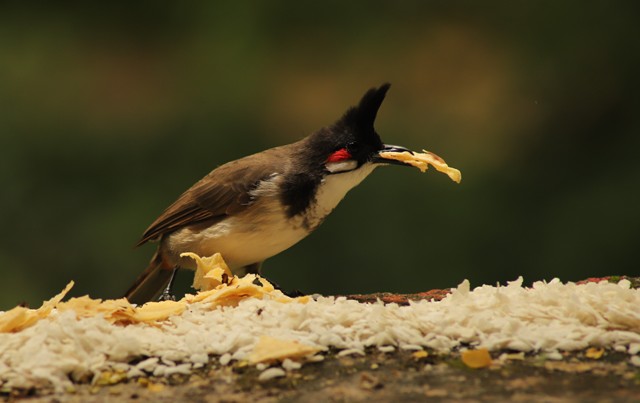
It is found both in urban and country side which has some trees to flit around in search of insects.
If any garden offers a bird-bath, the bulbul is a sure visitor to have a drink and enjoy his/her bath.
Around early mornings, just before noon and around early evenings are the most active time of bulbuls.
Nesting is somewhere between Feb-Aug and it readily takes to nesting in garden shrubs and small trees. The nest is well laid out cup like mass of grass and twigs.
2 to 4 eggs of pinkish white colour with brown and bluish blotches are laid and both parents share all domestic chores.
The young are very voracious and have a very un-bullbul like harsh ‘cheep’.
As they grow up with their devoted parents feeding them almost nonstop they grow very fast and by the time they fly away on their own they are endowed with the marvelous, melodious polyphonic voices.
A marvelous bird which easily accepts an invitation to gardens.
A bulbul pair nesting and being around in gardens is a delight.
Note:
These birds are regular visitors to my garden bird-bath.
One could set the time with their arrival for a bath and a drink at 4 in the afternoon.
A sure visitor to the garden which provides a bird-bath and a small tree or a put-up perch close by. They enjoy a bath everyday.
|
Did You Know ?
Value of biodiversity gets official OK
Readers may recollect a story some months ago – “Living together helps us all grow”. The piece was about how having many species growing together
led to more stable nutrition for all the species, as opposed to less, due to competition. Many species also helped
each one make a better showing against parasites.
Prof David Tilman and others at the University of Minnesota put these ideas about the importance of biodiversity to rigorous test and have demonstrated
with hard data that biodiversity does, indeed help all the participating species flourish and better combat drought our soil degradation. “Ecologists have long suspected that biodiversity affects various aspects of ecosystem functioning, but there has been
great debate among academic researchers because we lacked rigorous experimental tests”, Prof Tilman said in a communication.
Many species cooperate
The way more species help nutrition is that they help even out the rate of extraction of different components of the soil by the plants supported. Thus,
according to the rate of replenishment of the different soil components, by processes like nitrogen fixation,
seepage, bacterial action, etc, the mix of the species supported adjusts itself and
gradually stabilizes. All species are thus assured of steady supply of nutrients. If one species were to multiply faster, the tendency would be slowed down by depletion of the soil and if a population were to go down, abundant
food supply, as other species would not need to compete, would help the population rise again.
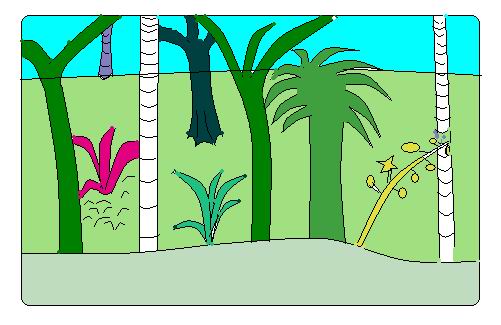
In the matter of attack by parasites also, the presence of other species prevents a parasite from taking over all the members of one species. Again,
increase of one species would face increased pressure from parasites, while depletion would result in increased protection by other plants, and hence regeneration.
Put to the test
These ideas of how biodiversity was ‘good’, however, had not been established by hard data of how different species fared when grown along with other
species or by themselves. Prof Tilman and his colleagues have filled the need by a decade-long experiment carried out in the Cedar Creek Natural History Area, Minnesota. Prof Tilman, who is Regents Professor and holds the McKnight Presidential University Chair
in Ecology at the University of Minnesota, is also the Director of the Cedar Creek Natural History Area.
Prof Tilman and colleagues divided a 7 hectare field into 168 plots of 9m x 9m each. The plots were seeded with 1,2,4,8 or 16 different perennial grassland
species – the mix of seeding being repeated at different levels of diversity. The composition of each plot was randomly chosen from 18 perennial plants and the plots were seeded in May 994 and 1995 and data collection continued for 10 years. Strict controls
were ensured of the conditions of growth the plots were burned every year in spring before growth began and the biomass generated was assessed, with controls for statistical rigour, in August.
The study covered both short term and longer term effects of different conditions, of the presence of weeds and of periods of drought. The data collected has established that “greater numbers of plant species lead
to greater temporal stability of an ecosystem’s above-ground plant production…………….Our results indicate that reliable, efficient and sustainable supply of some foods (for example livestock fodder), biofuels and ecosystem services can be enhanced by the use
of biodiversity”, says the report in Nature
[The writer can be contacted at simplescience@gmail.com].
|
News and Views
Express YOUR news and views at our
BLOG
The topics are,
Bio Diversity, Books, Climate Change and Global Warming, Community Reserves, E-governance for conservation, Eco-tour, Engineers and Environment, Environment Awareness, IWC E-zine, Film Reviews, General, Interlinking of rivers, nature/wildlife films, Tiger Task
Force Report, Tribal Bill-How will it affect our forests, Wildlife, Wildlife, Forest laws, Any other…………
You are invited to write on any of the areas covered by the above themes. If a topic of your interest is missing, tell us and we could add that too.
Log in to
BLOG
click on “Add blog”, log in with your email id and password and start writing. Use our simple ‘HTML’ editor to edit what you have written and click ‘submit’ to upload.
(TIP: Write your piece in the notepad first and then cut and paste it on to the blog pad; This will save time and avoid loss of data in the event you are logged out due to some reason.)
Do not worry about your ability to write; at IWC, what you say matters, not how you say it, or who you are.
Your audience is the large IWC membership PLUS all those who have opted to read anything written on similar topics online.
TEAM IWC
|
Poem
The Smartest and the Fastest: Investigating the limits of nature
Charles Graham Wells
On March 11, 2001, the London Sunday Telegraph reported that geneticists at a lab in India intend to clone the Asiatic cheetah, in hope of preventing the
animal's extinction. It's nothing special, I suppose-we have presided over other clonings, and other extinctions. But I find it interesting that we, who are capable of inserting cheetah DNA into a leopard's womb, were careless enough to kill so many cheetahs
in the first place. And there is something else that struck me, something about the very fact that we are trying to bring a large carnivore back into the game. I can imagine a time when cats and men were in competition: the cats killed the same grazing ungulates
that we might have wanted, and occasionally even killed us. But now we feel safe-so insulated from the jungle world, that, having nearly eliminated a species, we are trying to revive it. It seems that in the competition between brains, and claws, and wings,
and teeth, brains have won.
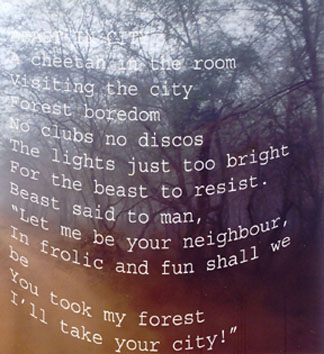
It is our universal science fiction fear that mankind will create a robot which can improve itself, ultimately taking power away from us. It's funny we fear that, because in the natural
world man is that robot. Intelligence has trumped the other weapons: it is the claw that sharpens itself. But it can be more than a claw, and we can be more than destroyers. It is unclear whether we will bring the cheetah back into the world. Perhaps we can't.
But we know that even failure can be hopeful, because we will learn from our mistakes. We have to, as the cheetah has to run. There is no difference: it's the steady drive of nature.
For Full Article go to
http://www.princeton.edu/~stcweb/html/pope02essay.html
Poem “Beast in City”-Saraswati Kavula
|
Story Of The Month
Ganga after Tehri Dam
-Saraswati Kavula
On a recent trip to Delhi, I decided to pay a visit to the Gomukh Glacier at Gangotri from which Ganga takes her birth. For the simple reason, that I had never seen a glacier before. My first stop
was Haridwar on a train, and then a local bus to Rishikesh. On the bus from Haridwar to Rishikesh, a lecturer from Lucknow University was sitting beside me. He was pointing out the various sites to be seen at Haridwar. As the bus took the turn out of the town,
we found a huge barrage on the Ganga. My fellow traveller pointed out, “This year, there was not much water at Haridwar. Only now, you are able to find this much water, since they started releasing the water from Tehri’ I asked him, ‘Do you come here often?’
‘Yes, we come every year, but ever since the dam has been constructed, the water levels in the Ganga had gone down. Only when they release the water from the dam, it increases’.
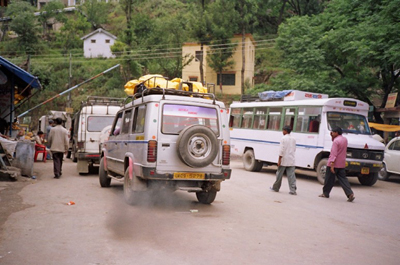
I stopped at the Garhwal Mandal Vikas Nigam to find out the route to Gangotri and about places to stay. They recommended that I take a package tour which allows me to visit Gangotri and Yamunotri
(The Birth place of River Yamuna) in six days time. After some contemplation, I declined and said I preferred to go on my own. So the lady told me to take a share taxi and make a stop either at Chamba or Uttarkashi. ‘Chamba is a lovely place; you will get
to see lots of mountain views. But since, it will be a longer journey from Chamba to Gangotri, you better stop over at Uttarkashi tonight. Even Uttarkashi is a lovely place. You will surely enjoy the stay there’.
So, from Rishikesh to Uttarkashi I travelled in a share taxi. The mountains above Rishikesh were wooded but not after a distance. On our way up we passed through Chamba. I tried to see what
was great about the place. Chamba was supposed to be a summer retreat, but the temperatures were crossing 30 degree Celsius. I could only see degraded land, and barren mountains, with hardly any forest, all the way beyond Narendra nagar up to Chamba and Uttarkashi,
except for some plantations, which were developed by the Forest department; a dusty town, with loads of plastics and trash tucked away in corners not seen from the main roads. It has pained me, for I was fond of the Himalayas very much, and was nearly visiting
them after eight years. I do not remember seeing this many years ago.
We stopped at the Tehri Reservoir to have some tea. The taxi driver pointed out and said, “this is the reservoir.’ I said then, ‘but there was a lot of opposition to the dam isn’t it? Lot
of villages got submerged?’ One of the fellow traveller in the taxi said, ‘yes, but people got compensated heavily, some people even cheated and got paid four times over’.
Then I said, ‘well, they might be the people in power like the sarpanch and mukhiya. Since, all over India, where ever they made dams, people have not received proper compensations, many of our people who got displaced in Nagarjunasagar, are living like
beggars even today’. The tea shop man said, ‘you are right madam, those who got compensated four times over were the powerful, many poor and powerless people did not receive compensation’. The tea shop man’s village was down below on the banks of the reservoir.
‘Earlier the distance between Tehri and Uttarkashi was 70 kms, today it has increased to 140 kms between New Tehri and Uttarkashi. So, our travel time has increased by two hours. On the other hand, this man would not have had his tea shop before the construction
of dam. This is the paradox’, added one of the local men who were having tea there. Sure enough the reservoir was beautiful, but was placid and not flowing like the river.
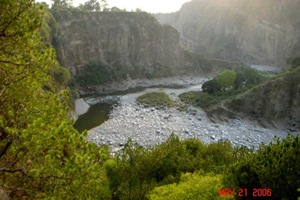
The road to Uttarkashi is quite breathtaking, but one finds the valley bereft of the famed waters, and one could only find dry beds in many places. Uttarkashi might once have been a pristine
little place, a base camp for the Nehru Institute of Mountaineering, but today, it is a bustling town with new high rise buildings and hotels coming all over the place, eating into the mountainside. Everywhere one finds, smoke spewing vehicles on the Gangotri
Highway. Being the pilgrim season, the entire place had the look of a busy road in a big city. The food was good, albeit not local food, it was Punjabi or Gujarati or even South Indian, but one could not find the local food anywhere. Not very surprising though!
Tourist demand does it! After a night stay on the noisy street in a small hotel, I left for Gangotri the next day morning. The bus was some sight. People were trussed like sardines inside it; it is no wonder that travel sickness is very common in the bus and
of course, helped the rent-a-car business very much. I hopped on to a share taxi once again and was off on the way up to Gangotri. Here too similar sights greeted me – loads of non-degradable trash lining the walls of the valley, which no doubt will join the
river pretty soon. All the way to the high mountains, one could see small hotels, motels lining the roads, not leaving much space for an unhindered view.
Photographs “Dry River Bed” -Kishan Rao,
Gangotri Highway-Saraswati Kavula
( To be continued.)
|